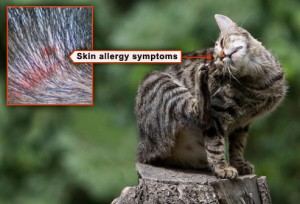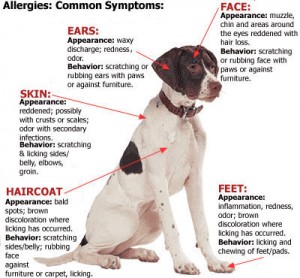Life’s an itch! Is an itch just an itch, or is it an allergy?
“Max”, the schnauzer next door begins to wheeze, scratch and chew at himself at the first sign of Spring. “Kitty”, the sweet tabby across the street gets an upset tummy whenever she eats a particular food. And “Ginger”, your very own lovable mutt, scratches herself raw anytime she’s bitten by even one flea. She even keeps you up at night with the constant scratching and collar jingling!
There are countless diseases that can cause pets to scratch including mange, fungal infections, ringworm, some bacteria, and even shampoo residue left on the pet’s skin after bathing. But the poor, uncomfortable pets mentioned above suffer from an affliction called allergies.
poor, uncomfortable pets mentioned above suffer from an affliction called allergies.
An allergy is the body’s reaction to a substance it can’t tolerate well. When the body comes in contact with an allergen (allergy-causing substance), either through physical contact, through something eaten, or by inhaling the substance, it produces antibodies and is called an allergic reaction. Common contact allergens include house dust, pollen, feathers, flea saliva, wandering Jew plants, ragweed, staph bacteria, and grass.
In pets, the allergic reaction can cause various symptoms including vomiting, diarrhea, and other gastrointestinal problem; respiratory problems; a runny nose and runny eyes; or itchy skin. Allergic pets will often lick their paws, scratch or rub their faces, or have watery eyes. Repeatedly red, or infected ears can also be a result of an allergic reaction. The constant scratching can produce bacterial skin infections and hair loss.
Flea allergy is the most common allergic reaction. Signs include intense itching, red skin, and the appearance of small, hard, red bumps called papules. The most common sites are the base of the tail (a common area for fleas), along the spine, and on the pet’s inner thighs and abdomen.
In halant allergy (called atopy) is the second most common allergic skin disease, mostly in dogs. At first, the condition is seasonal, but may become almost constant as the dog ages.
halant allergy (called atopy) is the second most common allergic skin disease, mostly in dogs. At first, the condition is seasonal, but may become almost constant as the dog ages.
Sensitivity to foods, rawhide chews, medications, and other ingested items, can occur. Food allergies are often diagnosed by blood testing, and by feeding an affected pet a hypoallergenic diet for several months. To complicate the allergy picture, a pet may have multiple allergy problems. So a pet with food allergies, for example, may also have atopy or flea allergy.
Diagnostic tests often done to accurately determine the cause of allergies. Intradermal skin testing for contact dermatitis and atopy, and blood testing for most allergies, are two methods used for diagnosis. Treatment may consist of trials of various antihistamines, as well as nutraceuticals (nutritional medications that assist the body’s natural defenses), steroids, or hyposensitization therapy, which is a series of injections to reduce the sensitivity to allergens. Antibiotics are often indicated when the constant scratching has caused a bacterial infection.
While there are no cures, pets can lead much happier, stress free lives when the allergens are identified, avoided and the symptoms eased through different treatments. Early detection can help prevent more serious problems from developing.


